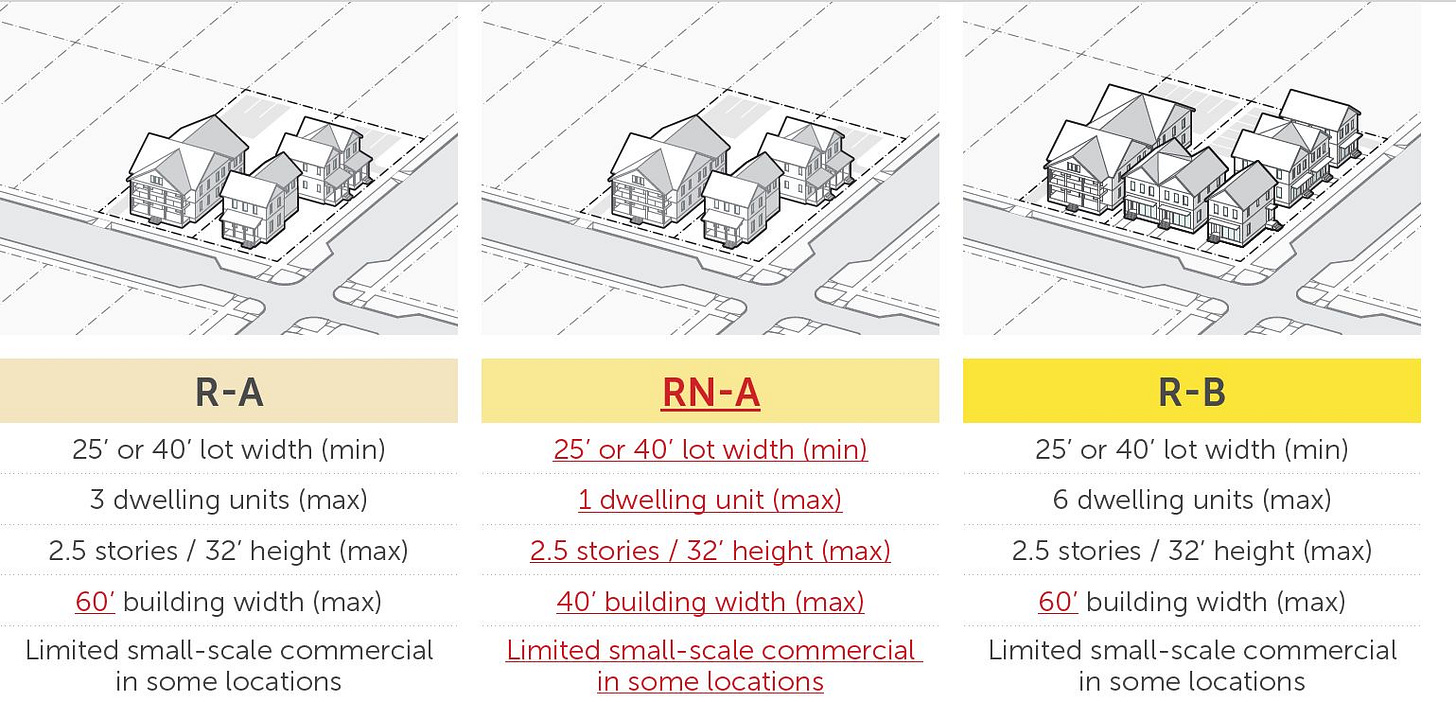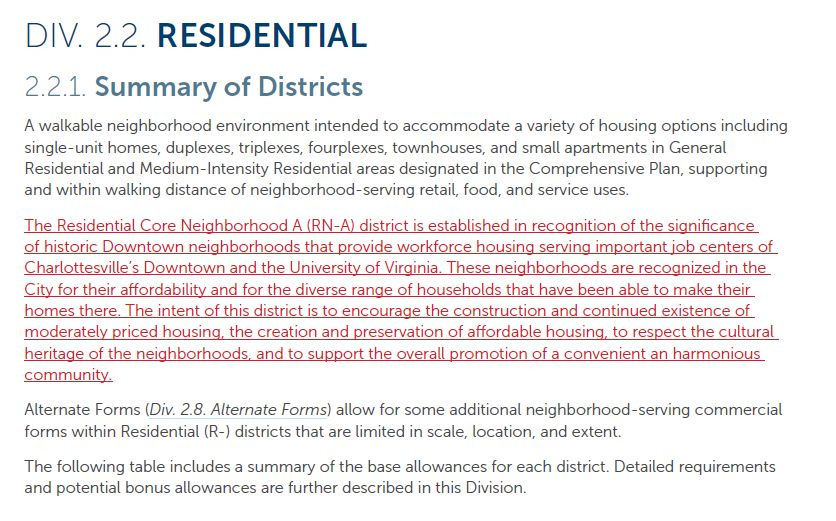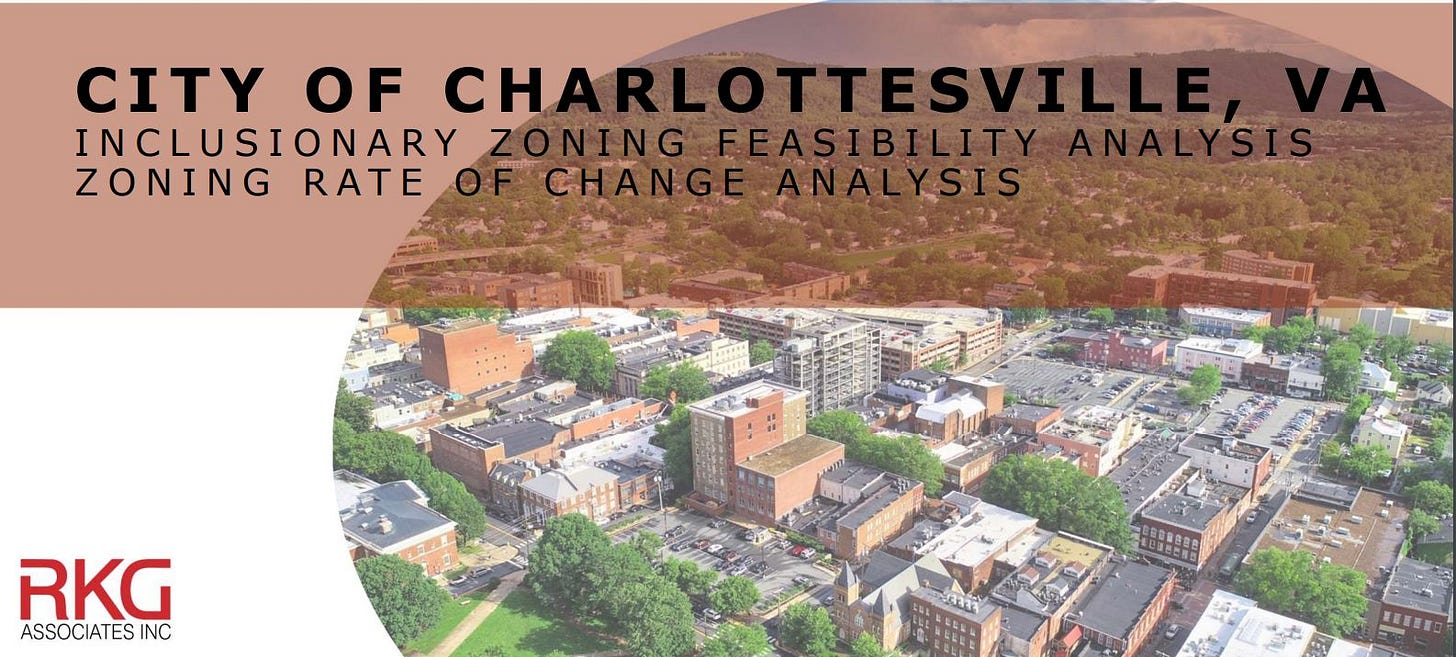December 4, 2023: Council briefed on affordability provisions in the Development Code
A summary of the penultimate work session on Charlottesville's proposed rules for new buildings
At the heart of it, Charlottesville Community Engagement is an experimental newsletter that’s taken many forms over the past three and a half years and at last 609 editions. Today’s edition goes out without the podcast and is a single segment due to a self-imposed desire to write up each of the Charlottesville City Council’s work sessions on the Development Code before the public hearing on December 5.
Turns out that’s tomorrow and I’m running out of time, so let’s get right to it.
Charlottesville City Council spent two hours on November 13, 2023 at their penultimate work session before the Public Hearing
The topic was the affordability provisions and gave members of the Housing Advisory Committee one last chance to explain why their recommendations differ from the Planning Commission on several key points
Council made no decisions and likely won’t until after the
The only shout-out today: Scouting Showcase
In today’s only subscriber-supported public service announcement: What are the benefits of Scouting for the community? The Monticello District of the Boy Scouts of America will hold a Scouting Showcase on December 7 at American Legion Post 74 where they’ll talk about service projects as well as programs for Cub Scouts. This covers youth in Charlottesville City, Albemarle County, Fluvanna County, Greene County, Louisa County, Madison County, and Orange County. The Scouting Showcase begins at 7 p.m.
American Legion Post 74 is located at 3025 Louisa Road in Keswick. Visit the Monticello District’s website to learn more!
An introduction to #609
As I said in the introduction, my hope had been to listen to every minute of Council’s work sessions on the Development Code before the December 5 public hearing and write up summaries.
To my knowledge, I’m the only person or institution attempting to give an objective summary of what’s actually in a zoning ordinance that has changed since both the Planning Commission’s public hearing on September 14 and their eventual recommendation on November 18. I am aware that Livable Cville has their take, and Citizens for Responsible Planning have theirs. My reports are those of a land use journalist who has been writing this beat since at least 2007.
There was a four hour discussion on November 29 which I am going to begin to listen to after I hit publish and will solely focus on listening to this while also learning to play guitar chords related to the bossa nova style. This will keep me focused and maybe I’ll get better. The goal there is better bed music for the podcast.
But this summary takes us back to November 13 and a discussion of the affordability provisions in the Development Code. That’s the name given to the rewrite of the zoning code to fulfill the goals and objectives of both the Affordable Housing Plan and the Comprehensive Plan.
There is no podcast version for three reasons. One, the audio was quite poor. Second, my studio computers are locked up recording other meetings. Third, I’m running out of time.
A review of the RKG report
The discussion on November 13 began with a review of a market analysis conducted to provide more information for the Planning Commission and City Council’s deliberations.
“It’s considered widely a best practice that if you’re seeking to adopt an inclusionary zoning ordinance that you do research into your local market for development costs and those such things to understand what your local market can bare in terms of an inclusionary zoning requirement,” said James Freas, the city’s director of Neighborhood Development Services.
The city hired the firm RKG Associates to conduct that analysis. (review the report)
Freas said that the Affordable Dwelling Manual that will be voted on separately recommends that analysis be updated every two years. A note that when a phrase is put in brackets, that is me as the writer explaining the acronym.
“Our [Affordable Dwelling Unit] rules as proposed would require that projects of ten units or more outside of residential districts—those are what we refer to as [Residential-A], [Residential-B], and [Residential-C]—must provide ten percent of the units as affordable for households earning up to sixty percent of the [Area Median Income],” Freas said.
The ordinance also requires those homes to be affordable in perpetuity which is represented mathematically as 99 years. If the homes are sold, they would be required to be affordable only to the first buyers.
Affordable units have to be built at the same time as market-rate units and have to look equivalent as well.
“We don’t want to attach a stigma or recognizable aspect to those units that are the affordable units within a project,” Freas said.
The ordinance also has bonus provisions for affordability in the residential zones. In Residential-A, a lot could have as many six units if three of them are affordable. In Residential-B and Residential-C there could be as many 12 units on a lot if six of them are affordable.
In the other districts, a developer can get additional height if affordable units are reserved for households at less than 50 percent of the area median income.
Sunshine Mathon, executive director of the Piedmont Housing Alliance, sat at the table as a member of the Housing Advisory Committee. He handed out paper copies of that group’s final recommendations which had been made at their special meeting earlier in the day.
The HAC recommended increasing the base affordability for sale units to 80 percent rather than the Planning Commission’s recommendation of 60 percent.
“If it had stayed as the Planning Commission had originally written, Habitat would no longer be able to build in the city by the way that they do things,” Mathon said. “So what we’re trying to do is thread the needle to allow for a multiplicity of homeownership options.”
HAC also recommended dropping a requirement for for-sale units be kept that way for 99 years as well as giving a right of first refusal to the City of Charlottesville or a qualified nonprofit. Instead, that requirement would only last through the first sale. Mathon said this would support both the Community Land Trust model to preserve communities and the Habitat model to allow for individual wealth creation.
“We wanted to allow for all of those options to be the case,” Mathon said.
In the mid-2000’s, Piedmont Housing Alliance developed several houses in the 10th and Page neighborhood and had a right of first refusal in the deeds. One three bedroom house sold on November 30 for $500,000 after having been originally sold for $250,000. PHA did not exercise their option to buy the property at a lower price. (View all transactions from November 2022)
Mathon explained the cost in this market has been too high for PHA to consider doing so.
“But at least we have that glimpse at it before it went to market,” Mathon said.
On March 9 of this year, Habitat exercised their right of first refusal for a house on Burnet Street in the Ridge Street neighborhood. They had sold the five bedroom home to a family in July 2016 for $219,900 and repurchased it for $345,000.
Freas said Councilors had to ask what they wanted to accomplish with the ordinance.
“We’re faced with a decision point with regards to is our primary objection with this portion of the ordinance with regard to ownership units creating a wealth-building opportunity or is our primary objective to create the long-term, sustained affordable ownership opportunity,” Freas said. “Those are very different options and either one is perfectly legitimate. We’re looking to Council to make a call on that.”
Vice Mayor Juandiego Wade said he supports the work that Piedmont Housing Alliance has been doing with the Piedmont Community Land Trust on homes in the Orangedale section of the Fifeville neighborhood. He thanked Mathon for the work.
“I think you all did a great job with that,” Wade said. “You are making them affordable for even some people who have been pushed out within the last few years. It’s given them an opportunity to come back.”
Wade may have been referring to an October 2 transaction that will be in my next property transaction report.
Perhaps the most vulnerable section of town in terms of displacement pressure in the Orangedale neighborhood in Fifeville. There are dozens of single-family attached homes and the prices have been increasing. The Piedmont Housing Alliance has been purchasing some of the units for the Piedmont Community Land Trust.
One of them on Prospect Avenue sold on this day for $160,000. As part of the sale, the Piedmont Housing Alliance gifted the lot to the Piedmont Community land Trust. The assessed value of the three bedroom house is $146,800 making this transaction 8.99 percent over the assessment. PHA paid $211,265 for the property in December 2021.
Wade also supported the Habitat model as well.
“Whichever one of those models allows us to work with both of those, that’s the language that I want,” Wade said.
Freas said his concern was that the right of first refusal would be codified in the ordinance at market rate rather than a lower cost. That would increase the cost to the City of Charlottesville should they want to buy the property to keep it affordable.
City Councilor Michael Payne sided with community benefit over individual wealth but that there is room for both.
“I do think as a policy direction we should be moving toward 99 years and a land trust model particularly because that is a newer and less used model for us here in Charlottesville,” Payne said.
How to get affordable housing in Residential Districts?
Mathon was at the meeting at the invitation of Charlottesville Mayor Lloyd Snook.
“One of the reasons I wanted to have you here was to have you explain how it is that we can get affordable units built in R-A, R-B, and R-C,” Snook said. “What’s going to have to happen to get those to work.”
Mathon said low-income housing tax credits would likely not be used unless these were scattered across multiple sites which does not have a precedent in Virginia.
“Fundamentally the viability of developing affordable units on R lots is going to be driven by additional necessary subsidy,” Mathon said. “We know fundamentally as RKG has highlighted [it takes] nine units of market rate to subsidize one affordable unit without additional subsidy is kind of the tipping point.”

Mathon said property owners could enter into partnership agreements with nonprofits, perhaps by entering into a long-term ground lease for a portion of the land for a low rate.
“That becomes a low-cost land entry point for a nonprofit to then leverage state and federal resources to deploy and help subsidize and bring those costs down in either a renter or homeownership context,” Mathon said.
Mathon said pending federal legislation could allow additional sources of subsidy for homeownership and that’s why the HAC wants the affordability bonuses in the residential lots.
Another item discussed was the HAC’s recommendation that additional height in the R lots be granted only if affordability is included. The Planning Commission recommended the height without a guarantee.
Mathon also cited door-to-door research done by the Public Housing Association of Residents and the Coalition for Low-Income Housing that claimed respondents wanted to restrict development rights in Fifeville, 10th and Page, and other neighborhoods. That’s the function of the Core Residential Neighborhood A district.
“They asked the question if we had to err on one side meaning strengthen preservation of the neighborhood versus wealth creation on the other side, the strong vast number of folks were on the preservation side,” Mathon said. “They’re already feeling the intensity of displacement over and over again.”
Mathon did not have access to the data at the meeting.

The Planning Commission’s recommendation for the RN-A district was to increase the number of units to three rather than two if the existing structure is kept. Mathon urged Council to reject that advice.
“But by keeping it at one as opposed to two, it also provides a bulwark against extractive or speculative developers who would otherwise come in to get three units instead of two,” Mathon said.
Pinkston, Wade, and Payne all supported the HAC over the Planning Commission.
An increase in cash-in-lieu fees
Next Council took up the idea of continuing the practice of allowing developers to pay into the affordable housing fund rather than building the units themselves. The rates would be higher under the new Development Code.
“Staff’s initial approach has been to assume that our objective is to get units in each project to the greatest extent possible and therefore our starting point has been that the fee-in-lieu would be based on construction costs,” Freas said.
Freas said the numbers would be based on third-party calculations rather than relying on what developers provide. Kyle Talente of RKG provided those numbers for this market.
“A studio construction cost has an estimate of about $184,000 whereas a three bedroom has a construction cost of about $547,000,” Talente said.
However, Freas said the cash-in-lieu payment for student housing projects would be charged a lower rate. What’s the difference?
“What we’re proposing as a definition is that the project rents by the bedroom and is located within a half mile of the University,” Freas said.
At one point, Councilor Payne said he would like to see the inclusionary zoning at 15 percent versus 10 percent in certain parts of the city, one of the suggestions in the RKG report. Freas said he would like to proceed as is for now but look back at the issue in two years.
The affordable housing manual will be adopted by Council after the Development Code possibly in January. The effective date of the new zoning won’t be until after Council takes that vote.
A preview of the November 29 meeting
At the tail end of the meeting, Snook asked why the idea of “house-sized” houses appears to have been dropped in Residential-A zones. He also made a similar comment back in April 2023 as I reported at the time.
“Right now the way things are drafted in a [Residential-A] zone, you could have a 9,000 square foot building without any bonuses, 9,000 gross floor area because you could have a 3,000 square foot footprint and you could have three floors,” Snook said. “I don’t know anybody who would say that a 9,000 square foot building is a house-sized building.”
Snook suggested a 4,500 gross square foot cap for floor area in the R-A zone and said the phrase “house-sized” was used to reduce concerns from neighbors about bigger buildings.
“When I was talking to people, I was trying to convince them that the Future Land Use Map we adopted two years ago was not going to be as heinous as they were afraid it was going to be, I relied on the notion that it’s going to be a house-sized building,” Snook said. “It’s not going to look and feel significantly different.”
Councilor Pinkston asked why this item had not come up sooner.
Freas said that the November 29 meeting would allow Council the chance to go through the zoning map and to also give CodeStudio a chance to explain and to explore the potential for a cap.
Time to load up the four hour work session and pick up my guitar.
The end of #609
Is a real edition of this newsletter? There’s just one segment, and I’m not entirely sure I’ve written anything I’ve not written before. There’s also only one shout-out and I skipped the reading material. But, I’m counting it because I’m President of Town Crier Productions and that means I make the decisions ultimately and I can tell my producer what to do. I also am the producer, too, and the guitar I mentioned earlier is my psychologist.
I’m grateful for all of the subscriptions that came in over the weekend, and I’ll eventually write personalized thank you notes to each of them. I recognize this is not a typical information source, but I’m hoping to keep going into the future. I believe every community needs access to information, and I’ve been living and working in this one for over 21 years now.
If you’d like to support the newsletter, here are some ideas:
Sign up for a paid subscription through Substack! Ting will match your initial payment as part of their unique sponsorship. There are over 550 of you who’ve taken this route.
Sign up for a subscription through Patreon, which means support for the overall Town Crier Productions project. This includes the Fifth District Community Engagement newsletter which will relaunch in 2024 but is on hiatus while this Development Code is completed.
Get in the habit of checking back through the Information Charlottesville archives so you can get a sense of all I’ve written about in the past four years.
Tell someone about the work!
The next one may very well be like this one and then I’ll be back to a normal format. There are so many stories I want to tell but this Development Code is my top priority. Please let me know if you have questions!
If you sign up for Ting at this link and enter the promo code COMMUNITY, you’ll get:
Free installation
A second month for free
A $75 gift card to the Downtown Mall






